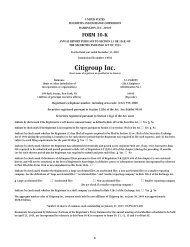7.3 billion - Citigroup
7.3 billion - Citigroup
7.3 billion - Citigroup
You also want an ePaper? Increase the reach of your titles
YUMPU automatically turns print PDFs into web optimized ePapers that Google loves.
liabilities on the basis of the net open risk position when certaincriteria are met. Citi has elected to measure certain portfolios offinancial instruments, such as derivatives, that meet thosecriteria on the basis of the net open risk position. The Companyapplies market valuation adjustments, including adjustments toaccount for the size of the net open risk position, consistent withmarket participant assumptions and in accordance with the unitof account.Valuation Process for Level 3 Fair Value MeasurementsPrice verification procedures and related internal controlprocedures are governed by the <strong>Citigroup</strong> Pricing and PriceVerification Policy and Standards, which is jointly owned byFinance and Risk Management. Finance has implemented theICG Securities and Banking Pricing and Price VerificationStandards and Procedures to facilitate S&B‘s compliance withthis policy.For fair value measurements of assets and liabilities held bythe Company, the front office traders are primarily responsiblefor valuing the trading account asset and liabilities, and Financeperforms independent price verification procedures to evaluatethose fair value measurements. Fair value measurements ofassets and liabilities are determined using various techniques,including, but not limited to, discounted cash flows and internalmodels, such as Black-Scholes and Monte Carlo simulation.When a position involves one or more significant inputsthat are not directly observable, price verification procedures aredesigned using the most relevant market data available and mayinvolve extrapolation, interpolation, review of relevant historicaldata, and stress testing. Based on the observability of inputsused, Finance classifies the inventory as Level 1, Level 2 orLevel 3.Reports of inventory that is classified within Level 3 of thefair value hierarchy are distributed to senior management ineach of Finance, Risk and the individual business. Thisinventory is also discussed in Risk committees and in monthlymeetings with senior trading management. As deemednecessary, reports may go to the Audit Committee of the Boardof Directors or the full Board of Directors.In addition, the pricing models used to measure fair valueare governed by an independent control framework. Althoughthe models are developed and tested by the individual business,they are independently validated by Risk Management andreviewed by Finance with respect to their impact on the priceverification procedures. To ensure their continued applicability,models are independently reviewed annually.Securities purchased under agreements to resell andsecurities sold under agreements to repurchaseNo quoted prices exist for such instruments so fair value isdetermined using a discounted cash-flow technique. Cash flowsare estimated based on the terms of the contract, taking intoaccount any embedded derivative or other features. Expectedcash flows are discounted using interest rates appropriate to thematurity of the instrument as well as the nature of theunderlying collateral. Generally, when such instruments are heldat fair value, they are classified within Level 2 of the fair valuehierarchy as the inputs used in the valuation are readilyobservable. However, certain long-dated positions are classifiedwithin Level 3 of the fair value hierarchy.Trading account assets and liabilities—trading securitiesand trading loansWhen available, the Company uses quoted market prices todetermine the fair value of trading securities; such items areclassified as Level 1 of the fair value hierarchy. Examplesinclude some government securities and exchange-traded equitysecurities.For bonds and secondary market loans traded over thecounter, the Company generally determines fair value utilizingvaluation techniques, including discounted cash flows, pricebasedand internal models, such as Black-Scholes and MonteCarlo simulation. The two primary valuation methods arediscounted cash flows and internal models. Fair value estimatesfrom these internal valuation techniques are verified, wherepossible, to prices obtained from independent vendors. Vendorscompile prices from various sources and may apply matrixpricing for similar bonds or loans where no price is observable.If available, the Company may also use quoted prices for recenttrading activity of assets with similar characteristics to the bondor loan being valued. The yields used in discounted cash flowmodels are derived from the same price information. Tradingsecurities and loans priced using such methods are generallyclassified as Level 2. However, when less liquidity exists for asecurity or loan, a quoted price is stale or prices fromindependent sources vary, a loan or security is generallyclassified as Level 3.Where the Company‘s principal market for a portfolio ofloans is the securitization market, the Company uses thesecuritization price to determine the fair value of the portfolio.The securitization price is determined from the assumedproceeds of a hypothetical securitization in the current market,adjusted for transformation costs (i.e., direct costs other thantransaction costs) and securitization uncertainties such as marketconditions and liquidity. As a result of the severe reduction inthe level of activity in certain securitization markets since thesecond half of 2007, observable securitization prices for certaindirectly comparable portfolios of loans have not been readilyavailable. Therefore, such portfolios of loans are generallyclassified as Level 3 of the fair value hierarchy. However, forother loan securitization markets, such as commercial real estateloans, pricing verification of the hypothetical securitizations hasbeen possible, since these markets have remained active.Accordingly, this loan portfolio is classified as Level 2 in thefair value hierarchy.Trading account assets and liabilities—derivativesExchange-traded derivatives are generally measured at fairvalue using quoted market (i.e., exchange) prices and areclassified as Level 1 of the fair value hierarchy.The majority of derivatives entered into by the Companyare executed over the counter and are valued using internalvaluation techniques as no quoted market prices exist for suchinstruments. The valuation techniques and inputs depend on thetype of derivative and the nature of the underlying instrument.The principal techniques used to value these instruments arediscounted cash flows and internal models, including Black-Scholes and Monte Carlo simulation. The fair values ofderivative contracts reflect cash the Company has paid orreceived (for example, option premiums paid and received).159CITIGROUP – 2012 FIRST QUARTER 10-Q
















